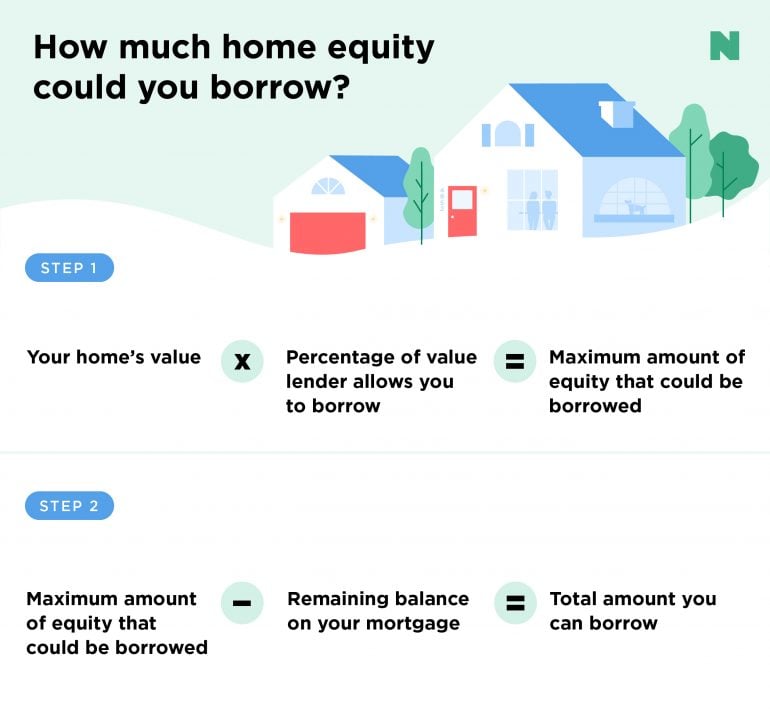What Is a Home Equity Line of Credit, or HELOC?

Many or all of the products featured here are from our partners who compensate us. This influences which products we write about and where and how the product appears on a page. However, this does not influence our evaluations. Our opinions are our own. Here is a list of our partners and here's how we make money.
What is a home equity line of credit?
A home equity line of credit, or HELOC, is a second mortgage that gives you access to cash based on the value of your home. You can draw from a home equity line of credit and repay all or some of it monthly, somewhat like a credit card.
With a HELOC, you borrow against your equity, which is the home’s value minus the amount you owe on the primary mortgage. You can also get a HELOC if you own your home outright, in which case the HELOC is the primary mortgage rather than a second one. When you’re shopping around for a loan, borrowing from the equity in your home will often get you the best rate.
Key takeaways
You typically have 10 years to withdraw cash from a home equity line of credit, while paying back only interest, and then 20 more years to pay back your principal plus interest.
Unlike with most loans, your rate will likely change based on market conditions over the life of the credit line.
For you to qualify for a home equity line of credit, lenders will usually want you to have a credit score over 620, a debt-to-income ratio below 40% and equity of at least 15%.
Most HELOC lenders will let you borrow up to 85% of the value of your home (minus what you owe), though some have higher or lower limits.
Because you risk losing your home if you can’t pay back your loan, a home equity line of credit is best reserved for expenses that will help build wealth (like home improvements and renovations) and for those who want to bolster their emergency funds.
A HELOC isn’t an appropriate way to finance vacations or depreciating assets like cars, and it wouldn’t be the best fit for someone who plans to sell their home in the near future.

How does a HELOC work?
Much like a credit card that allows you to borrow against your spending limit as often as needed, a HELOC gives you the flexibility to borrow against your home equity, repay and repeat.
You’ll have a few options to borrow money from this account. You can access it via online transfer or with a bank card at an ATM or point of sale (same as with a debit card), or you can write checks from the account if the lender issues them.
Most HELOCs have adjustable interest rates. This means that as baseline interest rates go up or down, the interest rate on your HELOC will adjust, too. However, because a HELOC is secured against the value of your home, the interest is typically closer to a mortgage rate than it is to a credit card rate.
To set your rate, the lender will start with an index rate and then add a markup depending on your credit profile. Generally, the higher your credit score, the lower the markup. That markup is called the margin, and you should ask to see the amount before you sign off on the HELOC.
There are two phases of a HELOC:
The draw period, when you can borrow money from the account, up to your approved limit.
The repayment period, when you can’t take out more money and have to finish paying off what you’ve withdrawn.
Payments don’t just begin during the repayment period; you’ll have to make minimum payments throughout the life of the loan. Interest is charged on your balance during both phases.
Monthly minimum payments often are interest only during the draw period, but you can pay principal if you want because this will save you money in the long run. The length of the draw period varies, but it’s often 10 years.
During the repayment period, you pay back the loan in monthly installments that include principal and interest. With the addition of principal, the monthly payments can rise sharply compared with the draw period. The length of the repayment period varies; it’s often 20 years.
At the end of the loan, you could owe a large lump sum — or balloon payment — that covers any principal not paid during the life of the loan. If this seems daunting, there are a few paths you can take to avoid this. For example, specifically seeking out a lender that allows you to lock in rates on your withdrawals will make payments more predictable. If you already have a HELOC, you could make larger payments than the required minimum to chip away at the principal faster. You could also change the terms of the loan by refinancing with a new lender.
HELOC requirements
Lender requirements will vary, but here's what you'll generally need to get a HELOC:
A debt-to-income ratio that's 40% or less.
A credit score of 620 or higher.
A home value that’s at least 15% more than you owe.
Save thousands on your loan by comparing competitive refi quotes
Get personalized quotes from our marketplace of lenders and negotiate your best rate. Answer a few questions to get started.
How to get a home equity line of credit
The process of getting a HELOC is similar to that of a purchase or refinance mortgage. You’ll provide some of the same documentation and demonstrate that you’re creditworthy. Here are the steps you’ll follow:
Determine whether you have sufficient equity, using a HELOC calculator.
Once you have an idea of what you can borrow, shop HELOC lenders.
Gather the necessary documentation before you apply so the process will go smoothly.
Once you have pulled together your documentation and selected a lender, apply for the HELOC.
You’ll receive disclosure documents. Read them carefully and ask the lender questions. Make sure the HELOC will fit your needs. For example, does it require you to borrow thousands of dollars upfront (often called an initial draw)? Do you have to open a separate bank account to get the best rate on the HELOC?
The underwriting process, though not as extensive as when you got your mortgage, can take weeks.
The final step is the loan closing, when you sign paperwork and the line of credit becomes available.
Don't assume the price you paid at closing is what your home is worth. During underwriting, your lender may order an appraisal to confirm the home's value. If home prices in your area have appreciated while you've owned your home, you'll also have more equity because the difference between the property's higher value and the amount remaining on your mortgage will be larger.
How much can you borrow?
The maximum amount of your home equity line of credit will vary based on the value of your home, what percentage of that value the lender will allow you to borrow against and how much you owe on your mortgage. Two quick calculations can give you an idea of what you might be able to borrow with a HELOC.
Your home's current value x Percentage of value the lender allows you to borrow = Maximum amount of equity that could be borrowed
Maximum amount of equity that could be borrowed - Remaining balance on your mortgage = Total amount you can borrow

Say you have a home worth $300,000 with a balance of $200,000 on your first mortgage and your lender will allow you to access up to 85% of your home’s value. Multiplying the home's value ($300,000) by the percentage the lender will allow you to borrow (85%, or 0.85) gives you a maximum amount of $255,000 in equity that could be borrowed. Subtract the amount you still owe on your mortgage ($200,000) to get the total amount you can borrow with a HELOC — $55,000.
Or skip doing the math, and use the HELOC calculator below to see how much you might be able to borrow.
Current HELOC rates
Rates will vary by lender, and the annual percentage rate, or APR, that you’re offered will depend largely on factors like your credit score, your existing debt and the amount you wish to borrow. However, most HELOC rates are indexed to a base rate called the prime rate, which is the lowest credit rate lenders are willing to offer to their most attractive borrowers.
Lenders will consider a borrower’s profile and add a margin to the prime rate to calculate a rate offer. For example, if a lender applies a margin of 1.45% to a prime rate of 7.5%, that borrower’s rate will be 8.95%.
Current prime rate | Prime rate last month | Prime rate in the past year — low | Prime rate in the past year — high |
|---|---|---|---|
7.75%. | 7.5%. | 3.25%. | 7.75%. |
HELOC rates don’t necessarily have to be higher than the prime rate — the margin applied by the lender can be negative. Some lenders choose to do this as part of an introductory offer to attract borrowers before switching to a positive margin later in the life of the loan.
Getting the best HELOC rate
The more you research, the bigger your reward. As you look for the best HELOC rates, get quotes from various lenders. Check your bank or mortgage provider; it might offer discounts to existing customers. Get a quote and compare its rates with at least two other lenders. As you shop around, take note of introductory offers like initial rates that will expire at the end of a given term.
Before you open a HELOC, you might look for lenders that offer a fixed-rate option. This lets you lock in your APR when you draw from your equity, which protects your loan from rising interest rates and can make long-term financial planning a little easier.
Is getting a HELOC a good idea?
Whether a home equity line of credit is a good idea really comes down to your goals and financial situation. A HELOC is often used for home repairs and renovations, which can increase your home's value. Another bonus: The interest on your HELOC may be tax-deductible if you use the money to buy, build or substantially improve your home, and the combination of the HELOC and your mortgage don't exceed stated loan limits, according to the IRS.
Some use home equity lines of credit to pay for education, but you may get better rates using federal student loans. Financial advisors generally don’t recommend using a HELOC to pay for vacations and cars because those expenditures don’t build wealth and may put you at risk of losing the home if you default on the loan.
Additionally, a HELOC may not be the best choice if you’re planning to move soon. One of the main benefits of a HELOC is its long borrowing and payment timeline, and you’ll have to pay it off entirely at the time of sale.
Disadvantages of a home equity line of credit
The main drawback of a HELOC is that it increases the risk of foreclosure if you can’t pay the loan. Regardless of your goal, avoid a HELOC if:
Your income is unstable. If it’s possible that your income will change for the worse, a HELOC may be a bad idea. If you can’t keep up with your monthly payments, your lender could force you out of your home.
You can’t afford the upfront costs. A HELOC may require an application fee, title search, home appraisal, real estate attorney fees and points. These charges can set you back hundreds of dollars.
You aren’t looking to borrow much money. A HELOC's upfront costs may not be worth it if you need only a small line of credit. In that case, you may be better off with a low interest credit card, perhaps with an introductory interest-free period.
You can’t afford an interest rate increase. HELOCs have adjustable rates. The loan paperwork will disclose the lifetime cap, which is the highest possible rate. Could you afford a monthly payment with that much interest? If not, think twice about getting the loan.
You’re using it for basic needs. If you need extra money for day-to-day purchases and you’re having trouble making ends meet, a HELOC isn’t worth the risk. It’s safer to get your finances in shape before taking on additional debts.
Variable rates leave you vulnerable to rising interest rates. Be sure to take this into account. Look at the size of the periodic cap (that's how much the interest rate can change at any one time) and the lifetime cap (the highest interest rate you could be charged over the life of the loan) to get an idea of how high your payments could get.
On the plus side, as with a credit card, you pay interest only on the amount of money you use, not the total credit line available to borrow.
How a HELOC affects your credit score
Although a HELOC acts a lot like a credit card, giving you ongoing access to your home’s equity, there’s one big difference when it comes to your credit score: Some bureaus treat HELOCs of a certain size like installment loans rather than revolving lines of credit.
This means borrowing 100% of your HELOC limit may not have the same negative effect as maxing out your credit card. Like any line of credit, a new HELOC on your report will likely reduce your credit score temporarily. However, if you borrow responsibly — making timely payments and not utilizing the full credit line — your HELOC could help you build your credit score over time.
What to do if you can’t keep up with your HELOC payments
Because most HELOCs have an adjustable rate, it’s possible your payments could exceed what you’d originally planned. If you can’t pay back what you’ve withdrawn, the lender could foreclose on your home; therefore, it’s important to act fast if you foresee a problem. Reach out to the lender to understand your options, and consider refinancing to lower your rate or change your payment terms.
Is it better to get a home equity loan or line of credit?
That depends on your financial situation and needs. A HELOC behaves like a revolving line of credit, letting you tap your home’s value in the amount you need as you need it. A home equity loan works more like a conventional loan, with a lump-sum withdrawal that is paid back in installments.
HELOCs typically have variable interest rates, while home equity loans are usually issued with a fixed interest rate. This can save you from a future payment shock if interest rates rise. Work with your lender to decide which option is best for your financing needs.
» MORE FOR CANADIAN READERS: What is a home equity line of credit?




